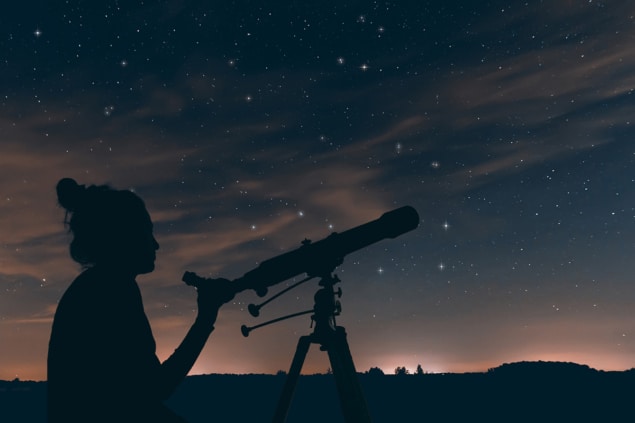Karel Green reviews The Sky Is For Everyone: Women Astronomers In Their Own Words edited by Virginia Trimble and David A Weintraub

As recently as the 1970s, the field of astronomy was so dominated by men that telescope facilities didn’t even have women’s toilets. Ann Merchant Boesgaard – who spent much of her research career studying the stars from telescopes on Hawaii after completing her PhD in 1966 – had to campaign for this basic amenity to be installed, as well as women’s dormitories for when they had to do overnight data collection.
Now an award-winning astronomer at the University of Hawaii, Boesgaard is one of 37 women who have shared their research journey in The Sky Is For Everyone: Women Astronomers in Their Own Words. Edited by American astronomers Virginia Trimble from the University of California, Irvine, and David A Weintraub of Vanderbilt University in Nashville, The Sky Is For Everyone is an anthology focusing on the stories and experiences of women in astronomy, both past and present – and it manages to fit a staggering amount of information into its 504 pages.
Before you get to the personal stories of current astronomers that make up the bulk of this book, there is an important introductory chapter entitled “Beginnings”. It provides a special reference, not only to the women featured in its pages, but also to those who could not be – and why. Trimble and Weintraub explain how they decided to focus on women who have doctorates so as to set a limit for the book. However, this policy does mean that there are people who could not be included because of the insurmountable problems they faced, either as an individual or group, while trying to gain a PhD and become a scientist. There were also others who were simply too busy to contribute to the book because of their day-to-day research and all the extra work people from any minority groups end up doing to stay in academia – whether it’s informal mentoring, helping with diversity and access, or maintaining support groups. As the editors point out, these are tasks that women in particular have to juggle, leaving them little time to do something like write a chapter for a book, however valuable that task might be.
But despite these omissions, the editors comment on the sheer volume of evidence, personal accounts, details and histories that still had to be excluded to keep to the publisher-set page limit. And for me, including this detail highlights that though there are more cis-men in astronomy than other genders, women now make up a significant proportion of the field – and are thriving and successful.
These women always became great scientists…proving again and again that excellent research comes primarily from where interest lies
“Beginnings” also presents a brief history of women in astronomy, providing valuable context for how much women have had to struggle to be part of the field. A timeline of the lives and work of female scientists from as early as the 1600s – when they couldn’t even give their own accounts of their labours – shows a common theme emerging, with each vignette containing essentially the same story.
A woman was viewed as a wife, sister, mother, daughter or other female relation to a man, and it was that man who had to grant her access to resources. If they were lucky enough to squeeze through the cracks and enter the world of astronomy, these women always became great scientists – albeit usually uncompensated and unrecognized – proving again and again that excellent research comes primarily from where interest lies.
Though this chapter holds much more information than I believe is possible to fully take in, it serves as a clear foundation for the book, demonstrating the history of barriers faced in the field and the women striving to break through them. Regardless of the location or situation, people have always looked up to the sky and questioned their place in the universe and this is why these fringe cases are so plentiful. Trimble and Weintraub also take care to acknowledge that most of the history of women in astronomy is told through a very white lens, with very few having other marginalized identities (such as being disabled or LGBTQIA+). Luckily much more diversity can be seen later in the personal accounts chapters.
A series of remarkable women
The remaining chapters of The Sky Is For Everyone are the individual stories of women currently in the field of astronomy. Starting with Anne Pyne Cowley of Arizona State University who got her PhD in 1963, the book is organized chronologically, ending with Yilen Gómez Maqueo Chew, who was awarded her doctorate in 2010 and is now at the Universidad Nacional Autónoma de México.
These personal accounts of each individual’s research journey is where this book shines. Real care and precision has been put into each piece, starting with the little details. For example, each chapter title is not just a name, but has the person’s PhD graduation year and a small subtitle relevant to their story. The editors have also included a summary of the scientist’s current position and research. This helps the reader become rooted in the lives of the women, and gives a brief overview for ease of access.
Despite the many decades that have elapsed since the astronomers featured early on in this book did their PhDs, lots of their stories mirror the problems people face today. Pyne Cowley, for example, mentions a lifetime of what is generally referred to as “the two body problem”, where she and her husband, both academics, struggled to find work and positions that would allow them to live together. This is still a common problem with many people having to decide if they want a career in academia that could see them living anywhere in the world and probably far away from loved ones.
Additionally, more serious topics come up. Pyne Cowley mentions a sexual assault that she survived many years ago, an event so traumatizing and horrible that it took her years to tell close friends and family due to the stress and fear that the man – who was well established in the field – would (and could) ruin her career. This, as well as racism, microaggressions and other bigotry are ever present throughout the book, and though it is of course difficult and upsetting to read at times, the realities of what people have gone through and how they dealt with it, or would deal with it now, are important to have recorded.
One welcome surprise in The Sky Is For Everyone is the perhaps unintentional portrayal of the organic evolution of astronomical research. Limited by technology and our understanding of the universe, many of the early scientists in the book are stellar and planetary physicists studying local objects. Saeko S Hayashi from the National Astronomical Observatory of Japan – a planet formation specialist who in 1987 became the first woman to receive a PhD in astrophysics from the University of Tokyo – recalls professors in her department scoffing at the mere idea of exoplanets. This is in contrast to later astronomers, such as Dara J Norman, who is based at the National Optical-Infrared Research Laboratory (NOIRLab) in Tucson, Arizon, and has been elected as the next president of the American Astronomical Society. Having gained her PhD in 1999, she now works on galaxy evolution and large-scale structures in the universe. Then there is Gabriela González from Louisiana State University (PhD 1995), who is a member of the LIGO Scientific Collaboration and searches for gravitational waves produced by binary star systems.
This book is a great information resource and a valuable archive of the lived experiences of female astronomers
The book does well in not censoring or watering down difficult topics, but – like many non-fiction anthologies – it is best read in short spurts rather than cover to cover. The Sky Is For Everyone is a great information resource and a valuable archive of the lived experiences of female astronomers. Theirs are stories that are desperately important but are rarely recorded in the detail that they should be.
- 2022 Princeton University Press 504pp £25hb



